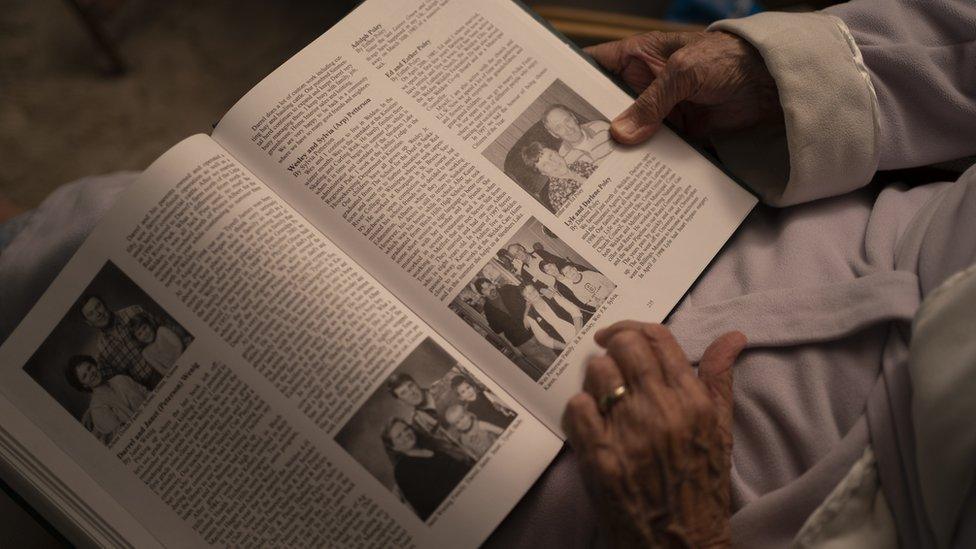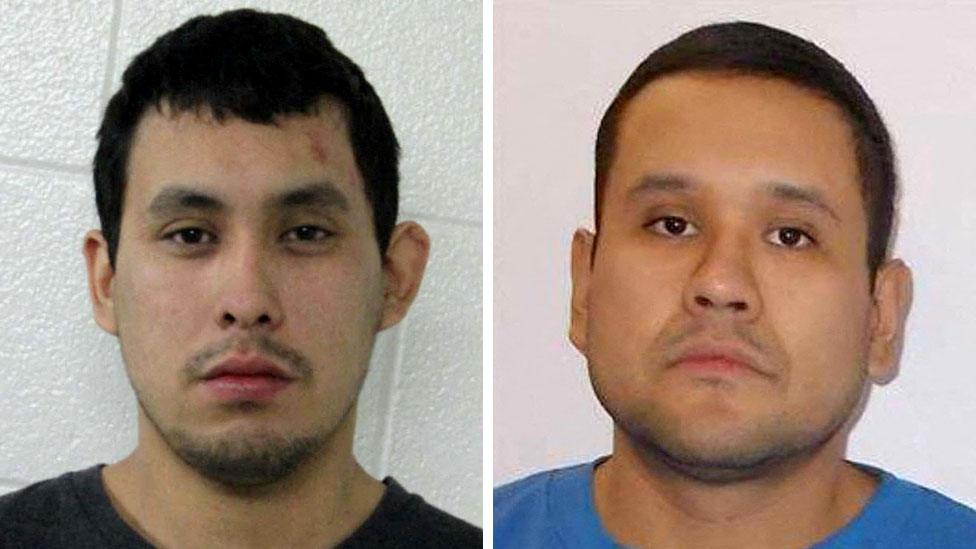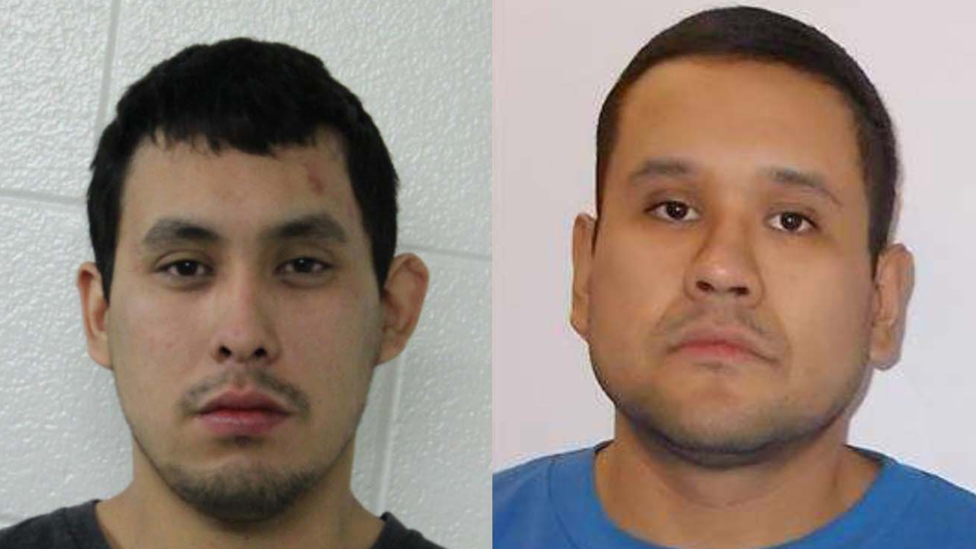Canada stabbings: Town 'shattered' amid stabbings manhunt
- Published
Watch: Deadly attack leaves residents in small town Canada afraid and mourning.
Three days after a deadly stabbing spree in Saskatchewan, the surviving suspect's whereabouts remain unknown.
The announcement of a possible sighting of Myles Sanderson in the James Smith Cree Nation area on Tuesday turned out to have been a false alarm.
He has been the target of a major police manhunt since Sunday after the attack that left 10 people dead and 18 injured, not including the suspects.
The attack has rocked the otherwise peaceful Canadian region.
Police have warned people to "take appropriate precautions" in an alert sent to mobile phones in the area.
Tuesday's false alarm will probably do little to calm the tension felt in the indigenous community of James Smith Cree Nation, where most of the victims were found, and the nearby town of Weldon, which is mourning the loss of long-time resident Wes Petterson, 77, who is reported to have been murdered in front of his house.
In Weldon, a small town of some 200 residents with gravel streets, a neat grid of single-storey homes, two churches, a post office and corner shop, most doors remain shut, though there are plenty of media present.
Residents are "right now, pushing up against the glass, looking out their windows", said Ruby Works, one of the few Weldon residents willing to speak to visiting media.
"Everyone is shattered."
The nearby James Smith Cree Nation has also issued a plea for privacy and time to mourn, and some media have been asked to leave.
Sunday's attack has prompted messages of condolence from around the world - including from Britain's Queen Elizabeth, who is also Canada's head of state. She said she was mourning alongside all of Canada.
"My thoughts and prayers are with those recovering from injuries, and grieving such horrific losses," the monarch said in a statement on Wednesday.
Saskatchewan police initially said on Sunday they were looking for two suspects - brothers Damien and Myles Sanderson, aged 31and 32 respectively - who they believed might have travelled 300km (185 miles) south to Regina following the attacks.
On Monday, police revealed they had found Damien Sanderson's body that morning during the course of their investigation in a grassy area near a house on James Smith Cree Nation.
Police say his body had "visible injuries not believed to be self-inflicted at this point". But police did not say whether Myles Sanderson was believed to be responsible for his brother's death.
They also said they had charged both men on multiple counts, including Myles Sanderson with three counts of first-degree murder, despite him not being in custody.
Police are confirming few details amid a complex investigation.
Beyond the search for Myles Sanderson, many questions remain in the case, including what drew the violence to Mr Petterson's doorstep.
"You can't find anything bad about him," said lifelong Weldon resident Doreen Lees, who was still using the present tense while speaking of her late friend whom she had known for three decades.
Mr Petterson was a gentle man, known around town for his homemade Saskatoon berry jam, and for the flower he liked to wear in his hat.
He would often drive Mrs Lees, 89, to the nearby community church where they both were members.
This past Sunday morning, a few hours before church services would usually begin, Doreen and her daughter Leona were on their front porch, taking in the view of the neighbouring fields while Leona had coffee.
A man approached, holding a jacket over his mouth, and asked for a ride.

Doreen Lees points out her friend Wes Petterson, killed on Sunday, in a Weldon community scrapbook
"He said, 'Can you help me? I've cut my face,'" Leona said. Believing he was injured she called for help, but the man fled.
Doreen and Leona are not sure whether it was one of the suspects, or someone else possibly involved, but police were quick to arrive that day and have since taken their statements.
For the first time ever, they have taken to locking their doors - but Leona has not stopped taking coffee on the porch in the morning.
"I did today, I will tomorrow," she said.
As the communities grapple with the grief, there have been appeals from police and indigenous organisations for people to come forward with any information.
"The uncertainty continues to cause immeasurable stress and panic among our families, friends, and neighbours," said Chief Bobby Cameron of the Federation of Sovereign Indigenous Nations, which represents all 74 First Nations of Saskatchewan, in a statement on Monday.
"They have already gone through enough. We must do everything we can to help end this tragedy without any more loss of life."
Earlier this week, Chief Cameron alluded to issues of substance abuse, saying in a statement that "this is the destruction we face when harmful illegal drugs invade our communities".
Myles Sanderson's parole documents from earlier this year, first reported by the Canadian Press and obtained by the BBC, suggest a history of substance abuse. Evidence of violent behaviour, past convictions including assault charges and childhood trauma are also indicated in his file.
"These murders weren't just caused by individuals making decisions," said Niigaan Sinclair, head of indigenous studies at the University of Manitoba. "And that's not a defence in any way."
The crimes were "heinous, they were horrible", said Prof Sinclair, who is Anishinaabe. "But these brothers were born into trauma and are now sharing that trauma with those around them."
Related topics
- Published6 September 2022

- Published5 September 2022
